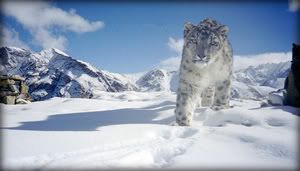 (Photo copyright American Himalayan Foundation, used with permission)
(Photo copyright American Himalayan Foundation, used with permission)Which is why AHF has teamed up with the Snow Leopard Conservancy to turn this conflict into collaboration, coexistence and conservation, creating more neighborly relations between the people of the region and this endangered cat.
Some of the solutions, which involve the entire community and make use of local experience and scientific solutions include...
Indoor night-time corrals with reinforced openings that snow leopards can't fit through; enhanced outdoor corrals, and solar electric fences (portable, inexpensive and effective) that help protect animals on the open range. According to Rodney Jackson of the Snow Leopard Conservancy, for every village's livestock pens made predator-proof, at least five snow leopards are saved, and people's attitudes about snow leopards are changing. Rinchen Wangchuk, SLC's field director in India, told Jackson recently: "At first the villagers could not understand why we had chosen for our organization the name of a despised predator. Today, their sentiments are echoed in the words of one: 'Wild animals are like the ornaments of our mountains!'"
According to the Snow Leopard Conservancy, corrals are one answer, but another part of the balance is to find ways to increase household income. One way to do that is through nature tourism. So they've helped organize home-stay programs where trekkers can stay in local homes, trained local people as guides that can show visitors snow leopard signs, and linked these economic incentives together with a monitoring program that helps keep track of the local snow leopards using "camera traps." Local people are also trained to set up the system of cameras, which are placed in the animal's natural habitat and automatically triggered to take a picture when an animal passes by, allowing scientists to take an elusive animal's photo without having to be there and without disturbing it.
In the early days, governments in the regions passed laws making it illegal to hunt snow leopards, but they couldn't enforce them in remote areas where the leopards are most common. Nor was it easy, with their limited budgets, for rangers to patrol such rugged habitat. Which is why Jackson believes the future of the species rests in large part with local communities, and is the best and only long-term, sustainable conservation strategy.
Much of the information in this post came from an interview with Rodney Jackson on the excellent PBS Show Nature, which recently aired an episode called, "Silent Roar: Searching for the Elusive Snow Leopard." You can read the entire interview, which includes other, growing threats to the snow leopard and what Jackson thinks about its future, as well as learn more about the Nature show and the snow leopard by visiting the PBS Nature web site.
(More snow leopard goodies to come!) :-)




3 comments:
Snow Leopards are one of my faves, they are beautiful!
Oh, I know Bella, aren't they magnificent? Did you happen to catch that PBS show about them? It was excellent. A magnificent animal in a magnificent part of the world.
Okay, I know I'm getting tired when I use "magnificent" three times in as many sentences! LOL! (At least I managed to spell it right...)
Post a Comment